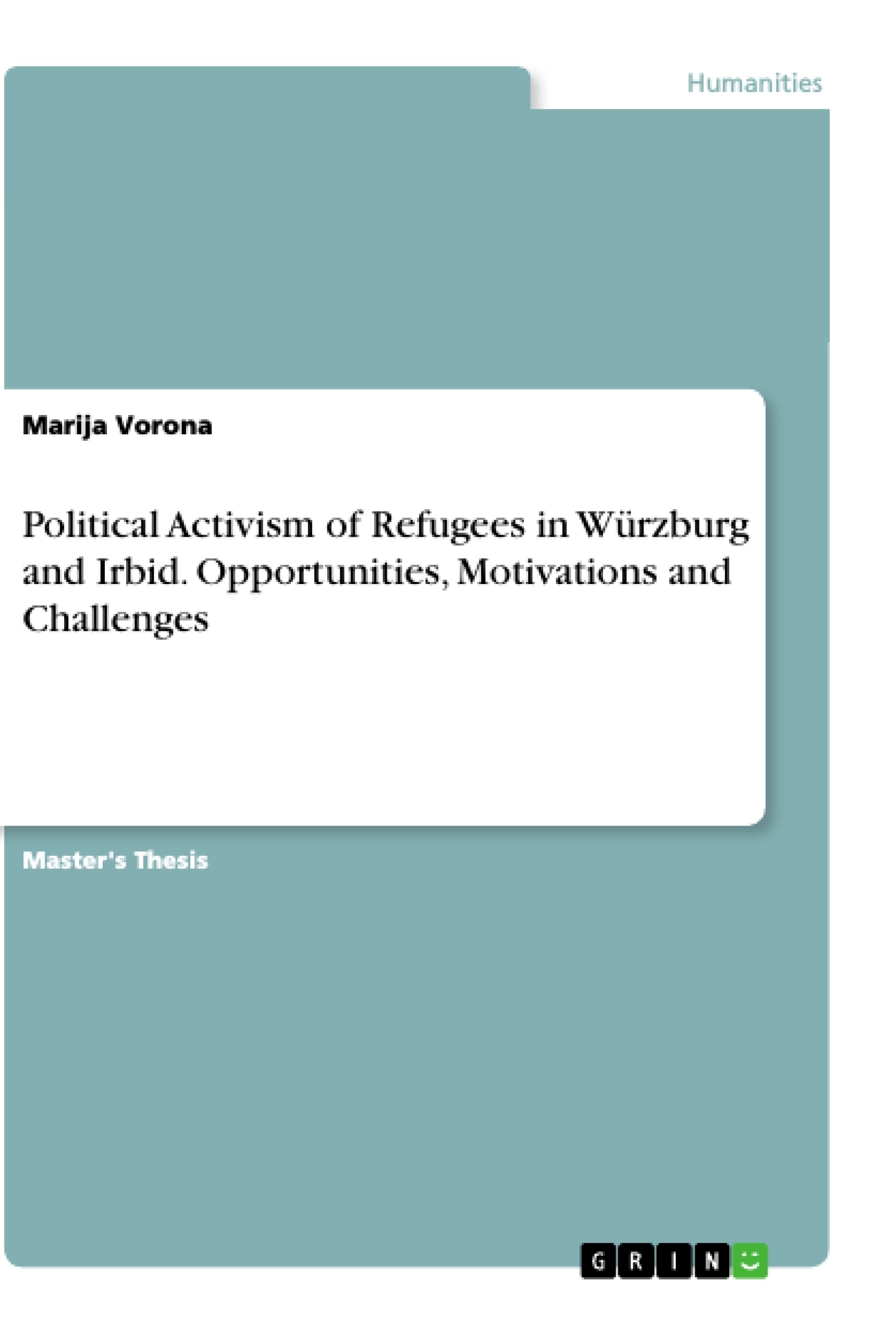The work will focus on forms of political activism taken on by refugees to partake in social discourse with their very own means and ways. By presenting their ideas, this work aims to give these people a voice and perceive them as individuals with their own history and opinion.
The refugee political activism will be examined in the two cities Würzburg in Germany and Irbid in Jordan. The aim is not to compare but rather to find out the opportunities, challenges and motivations of refugee political activism in widely varying contexts. The analysis of those aspects is important for the role of social workers, which they can or should play in integrating refugees into society and the political system.
The political discourse surrounding the "refugee question" is dominated by the negative sentiments in Germany and in Jordan. Through media refugees are often portrayed as victims, criminals or outsiders that are incapable of expression and void of agency.
This work provides a different perspective, examining the refugee situation in Würzburg and Irbid. Based on empirical findings gained from qualitative interviews, visible and invisible forms of protest actions, employed by the refugees, are conceptualized and presented. The situation is complicated by structural challenges and the need to weigh possible gains and losses of visible opposition to the state. The work concludes with a proposition for a differentiated approach to the "refugee problem", with emphasis on creativity, discussion and potential for human interactions.
Inhaltsverzeichnis (Table of Contents)
- Introduction
- Context
- Germany
- Jordan
- Definitions
- Universal category "Refugee"
- Legal Definition
- Critique
- Working Definition
- Activism and Activists
- What is "Political"?
- Universal category "Refugee"
- Theoretical Framework
- Acts of Citizenship
- Visible and Invisible Activism
- Contentious Politics
- Space of Encounter
- Personhood
- Research Design
- Research Question
- Focus on two cities: Würzburg and Irbid
- Methodology
- Qualitative Interviews
- Participants and Interview Setting
- Transcribing and Data Analysis
- Challenges of the Research
- Categories of activism in Würzburg
- Grounds and Aims for Protests
- Protest: Strive for Visibility and Change
- Reaction to the Protest
- Changes: Success of Political Activism?
- Vision for the Future
- Categories of activism in Irbid
- Refugees in the Society
- Illegal Work is Legal
- Challenge of Education
- Non-participation or Strategy of Silence
- Missing Future Perspective
- Interpretation of Findings
- Summary Statements of the Findings
- Würzburg
- Irbid
- Connecting Findings in Würzburg and Irbid
- Limitations and Strengths of the Study
- Implications for Future Research
- Summary Statements of the Findings
Zielsetzung und Themenschwerpunkte (Objectives and Key Themes)
This study examines the political activism of refugees in Würzburg, Germany, and Irbid, Jordan, aiming to challenge the prevailing narrative that portrays refugees as passive victims or outsiders. Through qualitative interviews, the research investigates visible and invisible forms of protest employed by refugees, considering the structural challenges and potential gains and losses associated with visible opposition. The study advocates for a more nuanced understanding of the "refugee problem," emphasizing creativity, dialogue, and the potential for human interaction.- Exploring the political agency and activism of refugees in different contexts.
- Analyzing the motivations, challenges, and strategies employed by refugees in their political engagement.
- Challenging dominant narratives surrounding refugees and their perceived lack of agency.
- Highlighting the role of structural factors in shaping refugee activism.
- Promoting a more inclusive and nuanced understanding of the "refugee problem" through the lens of human interaction and dialogue.
Zusammenfassung der Kapitel (Chapter Summaries)
- Introduction: The introduction sets the stage by addressing the negative discourse surrounding refugees in Germany and Jordan, where they are often portrayed as victims or outsiders. This study aims to offer a different perspective by examining refugee activism in two cities, Würzburg and Irbid.
- Context: This chapter provides context by outlining the refugee situation in Germany and Jordan, highlighting the specific challenges faced by refugees in each country.
- Definitions: This chapter defines key concepts such as "refugee," "activism," and "political," laying the groundwork for understanding the study's theoretical framework.
- Theoretical Framework: This chapter introduces the theoretical lenses that guide the study, including Acts of Citizenship, Visible and Invisible Activism, Contentious Politics, Space of Encounter, and Personhood. These theories provide a framework for analyzing refugee activism in different contexts.
- Research Design: This chapter outlines the study's methodology, including the research question, focus on Würzburg and Irbid, qualitative interviews, and data analysis. It also discusses the challenges encountered during the research.
- Categories of activism in Würzburg: This chapter explores different forms of activism observed in Würzburg, focusing on the grounds and aims for protests, the visibility of these actions, the reactions to them, and the potential impact of political activism on the lives of refugees.
- Categories of activism in Irbid: This chapter examines the diverse forms of activism practiced by refugees in Irbid, considering their integration into society, the prevalence of illegal work, the challenges faced in accessing education, and the strategies employed to cope with a lack of future prospects.
Schlüsselwörter (Keywords)
The study explores key concepts such as refugee activism, political participation, visible and invisible protest, structural challenges, agency, integration, and the discourse surrounding refugees in both Germany and Jordan. It draws on theoretical frameworks such as Acts of Citizenship, Contentious Politics, and the concept of Space of Encounter to understand the complex realities of refugee activism in diverse contexts.- Quote paper
- Marija Vorona (Author), 2018, Political Activism of Refugees in Würzburg and Irbid. Opportunities, Motivations and Challenges, Munich, GRIN Verlag, https://www.grin.com/document/540676



